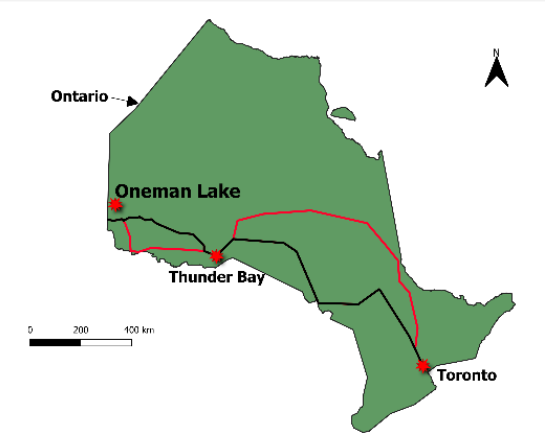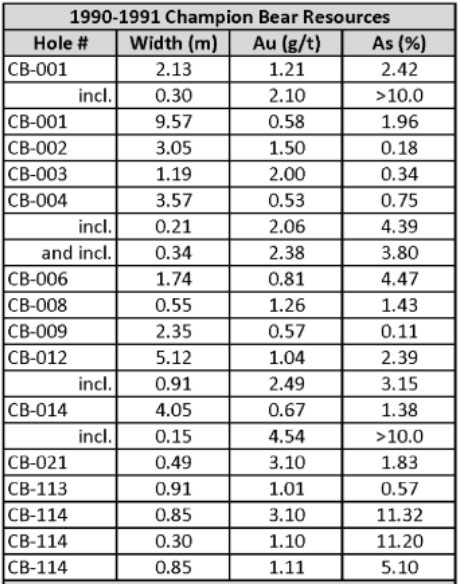Oneman Lake Property Report
Located in the Winnipeg River Subprovince
Date Completed: September 2024
Primary commodity: Au-Zn
Secondary commodity: Cu-Pb
Project size: 578 ha
Claims Renewal Date: 2026/06/06
Project UTM Location (Center of Property): NAD83 Zone 15U 376084 E 5572967 N
Project Location Description: The Oneman Lake property is located ~60km north of the town of Kenora, ON, which is a full-service historic mining and forestry town with a population of ~15,000 people (Fig. 1). The property is accessible by boat from Oneman Lake, which is connected to Kenora by the ON-525 and ON-596 Highways.
Geology

Figure 2. Project location and geology map of the Oneman Lake property. Area of gold-bearing sulfide breccia is shown on the map.
The Oneman Lake property is located in the Winnipeg River Subprovince and is only ~5km west of the boundary with the English River Subprovince (Fig. 2).
The main east-trending sulfide-bearing breccia zone on the property is hosted within amphibolites that likely represent the westernmost remnants of an attenuated major fold of the Separation Lake greenstone belt. Granitic and gneissic rock envelop the amphibolite unit, which is primarily composed of hornblende and biotite with lesser garnet. The sulfide-bearing breccia zone reaches up to ~100m in width, and contains several sulfide species including arsenopyrite, pyrite, pyrrhotite sphalerite, as well as minor chalcopyrite and galena. Gold, silver, zinc, and weak copper mineralization is prevalent throughout the sulfide breccia zone.
Additionally, the property is only located 6-7 km west along strike of Avalon Advanced Materials beryllium-tantalum-lithium bearing Rattler, Wolf and Glitter LCT pegmatites. This is significant considering that several intervals of pegmatite dykes have been recorded in the diamond drill hole logs from the property.
Project Summary
The Oneman Lake property was initially discovered by A. Gauthier in 1930. Trenching and sampling were completed by A. Gauthier et al. in 1948.
In 1969, additional sampling as well as a geophysical survey were carried out by Gauthier et al. In 1985, Sparton Resources Inc. completed an additional geophysical survey.
Further trenching, sampling, and an airborne geophysical survey were completed in 1989 by Champion Bear Resources Ltd., who also completed 22 diamond drill holes totalling 2497.5m in 1990-1991.
Limited work has been carried out on the property since then.
Proposed Next Steps
Next steps for the Oneman Lake property would include completing a detailed review of drill core and surface occurrences of the sulfide breccia and surrounding host rock with an emphasis on understanding the structure of the ore body.
Considering the host amphibolite rock represents an attenuated major fold, there is likely a strong structural control on the distribution of the sulfide breccia.
Understanding the geometry of the host rock should allow for better prediction of where wider, higher-grade intercepts of the sulfide breccia will occur. A subsequent drill program based on the results of the structural study could then be completed.
Additionally, it would be pertinent to reevaluate the potential of lithium mineralization in the pegmatites that have been documented to occur in the diamond drill holes on the property considering the proximity to Avalon Advanced Materials beryllium-tantalum-lithium bearing Rattler, Wolf and Glitter LCT pegmatites.
Table 1. 1990-1991 Champion Bear Diamond Drill Hole Results
Historic pits on the breccia zone were sampled in the 1940’s:
Pit 1: 0.08 oz/t Au (2.48 gpt), 0.38 oz/t Ag (11.82 gpt) and 7.85% Zn, 0.04 oz/t Au
Pit 2: 0.05 oz/t Au (1.55 gpt)
Pit 3: 0.12 oz/t Au (3.73 gpt)
Pit 4: 0.08 oz/t Au (2.48 gpt)
Pit 5: 0.10 oz/t Au (3.1 gpt), 2.77% Zn
Pit 7: 0.06 oz/t Au (1.86 gpt)
Additionally, a sample collected by Blackburn and Young, 2000, returned 9620 ppm Zn, 460 ppm Cu, and 2.4 g/t Au.
Diamond drilling completed by Champion Bear Resource Ltd. in 1990-91 was successful in confirming gold mineralization at depth in the sulfide breccia zone. Highlights from the drilling include 5.12m @ 1.04 g/t Au in CB-012, and 9.57m @ 0.58 g/t Au in CB-001. Additional drill results are shown in Table 1.


